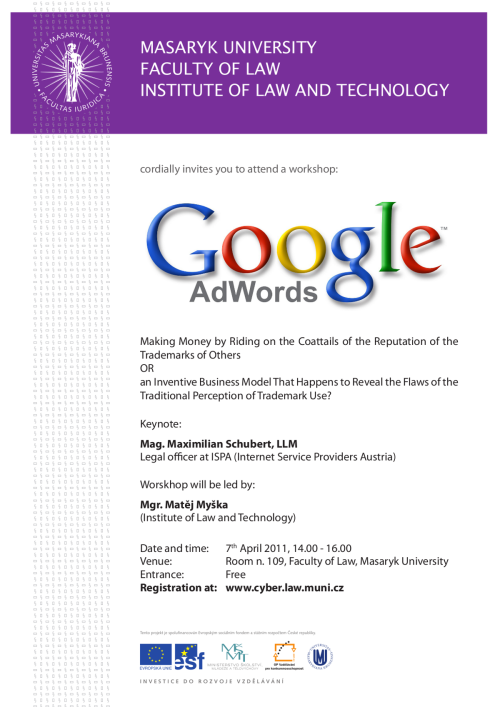 Advocate General (AG) Jääskinen delivered his opinion on the 24th of March on the 7th ECJ Keyword Advertising case: C-323/09 Interflora Inc Interflora British Unit v Marks & Spencer plc Flowers Direct Online Limited. For a short summary on the AG’s main points please see the IPKats (in English) or the Links&Law website (in German).
Advocate General (AG) Jääskinen delivered his opinion on the 24th of March on the 7th ECJ Keyword Advertising case: C-323/09 Interflora Inc Interflora British Unit v Marks & Spencer plc Flowers Direct Online Limited. For a short summary on the AG’s main points please see the IPKats (in English) or the Links&Law website (in German).
Other than reported in some newspapers the author can’t see a big ‘win‘ for TM owners as the AG repeatedly stresses the general admissibility of keyword advertising [par 45, 45] and the need to promote competition and well informed users [par 99].
- The AG highlights that there is a special ‘secondary meaning‘ in regard to the trademark INTERFLORA (due to its franchise system [par 46 – 48]) while at the same time, the trademark itself is exceptionally distinctive or even unique [par 72]. Thus even if the court established an infringement based on Art 5 (1) TMD, the ratio of this decision will be difficult to expand onto other keyword advertising decisions.
- Concerning the protection granted by Art 5(2) TMD the court elaborates on the preconditions of a mental link between trade mark and the keyword [par 65 ss]. The AG’s opinion is, that this precondition is fulfilled “in the rather exceptional case of the INTERFLORA trade mark” [par 72]. Although the AG finds the precondition of a mental link to be fulfilled in this special case, he later states that the M&S ad did not lead to ‘blurring‘ [par 91], ‘tarnishment‘ [par 92] or might be seen as unfair ‘free riding‘ [par 105]. As a consequence the AG didn’t see any infringement under Art 5 (2) TMD.
Two issues to be discussed at this point are whether 1.) the use of the term “some member of the public” will help to clarify the ECJ’s previous Google France ruling in regard to the adverse effect on the function of indicating origin and 2. ) what makes the INTERFLORA trademark so special in the opinion of the AG:
.
“Average user” vs. “some members of the public“?
We are left to see whether the use of the term ‘liable to lead some members of the public” [par 49 ] alongside/instead of the term “average internet user ” [par 99 Google France] will bring the desperately needed clarification to the problems raised by the Google France decision on this issue or will national courts to continue with their contradicting views on this matter:
To the understanding of the author, the average user is kind of an “arithmetical average” of the web-savvyness of e.g. 10 internet user. So if 30 out of 100 users are experts, 20 are completely clueless and the rest is somewhere in between, the average internet user – which courts will refer to when asking how an average user would respond to a certain situation – will be assumed “slightly” more web-savvy than some random user.
When applying the same the example of 30-50-20 users to the term “some member of the public” the 20 -clueless – users will get it wrong / be confused.
Following this ration the terms might, bases on the same conditions, might come to different outcomes and it is questionable to see if this was intended or if there was any other reason for the use of this term.
.
What is so special about the INTERFLORA trademark?
“47. Therefore, in my understanding, in addition to its registered meaning, the trade mark INTERFLORA has gained a ‘secondary meaning’ (36) denoting a certain commercial network of florists providing a certain type of delivery service, and the reputation of that trade mark relates to or is identical with the positive associations this meaning has in the minds of the relevant circles of consumers. (37)
48. Consequently, an association between the trade mark of Interflora and an identical delivery service of flowers provided by Marks & Spencer is possible and even likely in the mind of an average consumer seeking information about such services in the internet when faced with the following ad: (38)
‘M&S Flowers Online
http://www.marksandspencer.com/flowers
Gorgeous fresh flowers & plants. Order by 5pm for next day delivery.’ [please see reconstructed sample ad at the beginning of this post]
To my mind the display of the ad as a consequence of typing ‘interflora’ into a search engine creates in the context of this case an association that Marks & Spencer is part of the Interflora network.”
When looking into the footnotes it becomes a slightly bit clearer what the AG was trying to say, referring to a book written about 40 years ago…
36 – The notion ‘secondary meaning of a trade mark’ is known in all jurisdictions but its meaning (sic!) and its scope of application vary. In some jurisdictions it relates to situations where a trade mark right is acquired through use instead of registration, in others also to situations where a non-distinctive sign may be registered as a trade mark because it has acquired distinctive secondary meaning. It is also possible to think that every trade mark without exception needs to be used in order to become established in the minds of the interested circles, thereby acquiring reputation or established secondary meaning. Cf. Holmqvist, L., Degeneration of Trade Marks. A Comparative Study of the Effects of Use on Trade Mark Distinctiveness, Jurist- och samhällvetareförbundets Förlags AB (JSF), Malmö 1971, p. 117‑126.
37 – Whether INTERFLORA has such a secondary meaning is up to the national court to decide. However, question 4(a) seems to imply such meaning as the relevant trade mark registrations (see above, footnote 3) do not give any hint of INTERFLORA being used as a trademark in relation to a commercial network.
.
A more in-depth analysis, also dealing with the complicated relationship between Art 5 (1) a TMD and Art 5 (2) TMD and the influence Google’s TM policy changes, will hopefully follow soon be provided on this blog or at the Google AdWords Workshop on the 7th of April 2011 14:00-16:00 at Masaryk University:







I believe that sentence “liable to lead some members of the public” is derived from C-373/90 case – see paragraph 15 and 16 (“fact would have deterred a significant number of consumers from making a purchase”).
That judgment is called upon in subsequent judgments concerning misleading advertising: C-159/09 Lidl, paragraph 49; C-356/04 Lidl Belgium, paragraph 80; C-210/96 Gut Springenheide, paragraph 34.
I don’t like it too 🙂